
German postcard by Ross Verlag, no. 643/10. Photo: Decla. Louis Brody, Fern Andra and Hans Heinrich von Twardowski in Genuine (Robert Wiene, 1920).
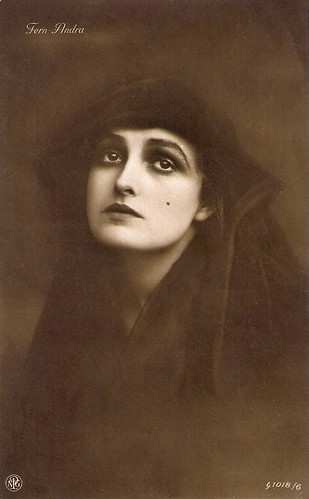
German postcard by Neue Photographische Gesellschaft (NPG), no. 1018/6.
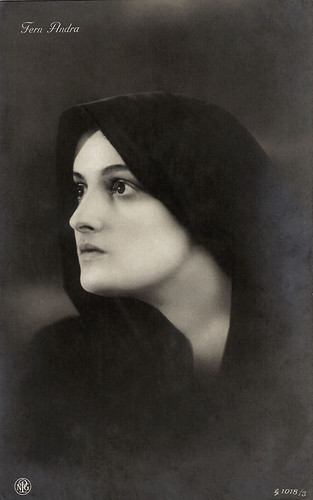
German postcard by NPG, no. G 1018/3.
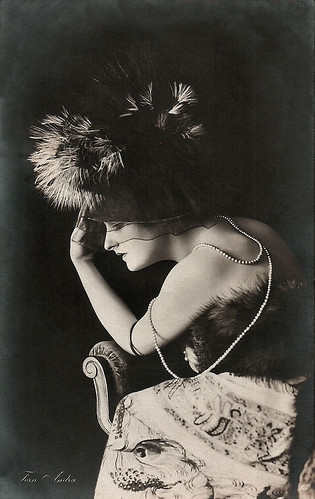
German postcard by Deutsche Gaumont-Gesellschaft, Berlin, no. 15. Photo: Fern Andra Atelier.
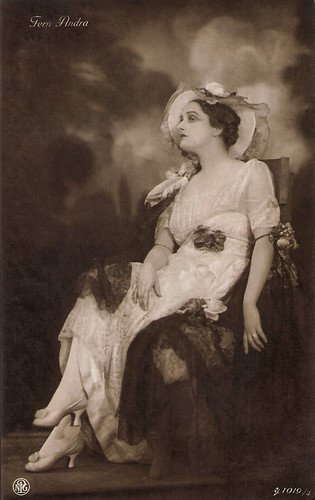
German postcard by NPG, no. G 1019/4.
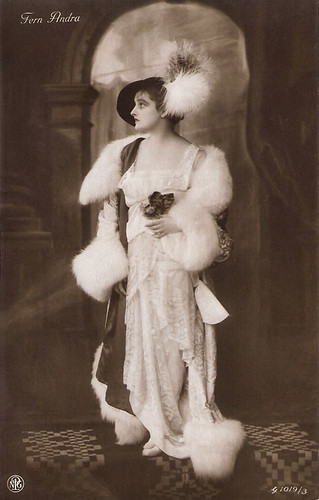
German postcard by NPG, no. G 1019/3.
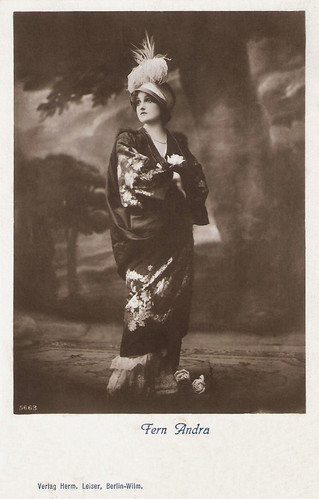
German postcard by Verlag Hermann Leiser, Berlin, no. 2226.
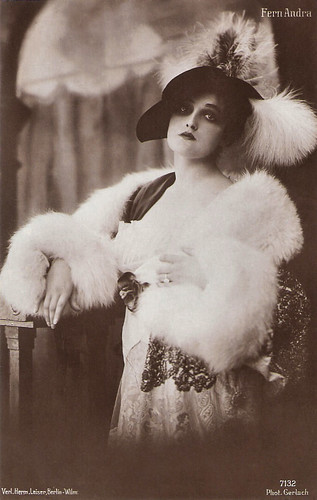
German postcard by Verlag Hermann Leiser, no. 7132. Photo: Gerlach.
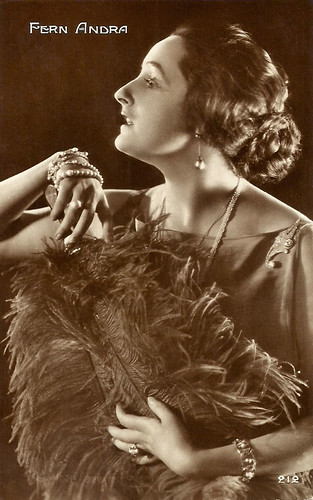
French postcard by Ed. Cinémagazine, no. 212.
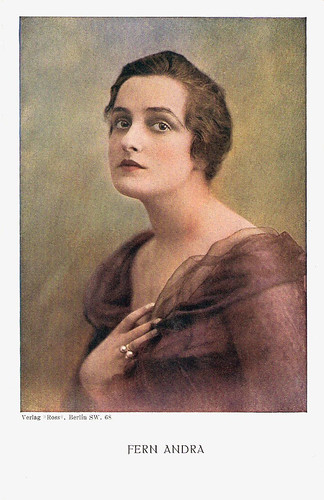
German postcard by Ross Verlag, Berlin.
Circus Dancer
Fern Andra was born as Vernal Edna Andrews in Watseka, Illinois, USA, in 1893. She was the daughter of William P. Andrews and Sarah Emily Evett, also known as Sadie.
When William died in 1898, Sadie remarried Frank St. Clair, a vaudeville actor, circus performer and tight-rope walker. Andra was already appearing in public in a tightrope act by the age of four. She later trained in song and dance. Wikipedia mentions that she made her first film in New York in 1899, a version of Uncle Tom's Cabin, but IMDb does not mention this production, and Hans Michael Bock at Filmportal writes that it was her stage debut.
However, she remained with the circus, with which she embarked on an extensive tour across the United States, Canada and Europe. For a time, she was a member of Bird Millman's acclaimed troupe of wire artists. In London, she became an outrageous ballerina at the Ragtime Revue. In Vienna, she became a student of famed director-teacher Max Reinhardt and appeared in several of his plays and films.
In Berlin, French film director Charles Decroix convinced her to start a career in film. He launched her as André Fern, competing with the leading German stars of those days: Asta Nielsen and Henny Porten. In 1913, aged 19, she appeared in her first German film, Das Ave Maria/The Ave Maria (Charles Decroix, 1913).
Equipped with her aquiline nose, ephebic little body and malicious eyes, Fern showed in short films like Der Stern/The Star (Charles Decroix, 1914) and Ernst ist das Leben/Life is Serious (Fern Andra, 1916), that she possessed a completely 'modern' repertory. Still only moderately well known, she made her only Austrian film in 1915: Zwei Freunde/Two Friends.
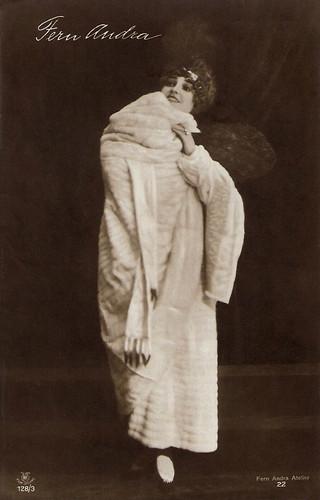
German postcard by Rotophot, Berlin, in the Film Sterne Series, no. 128/3. Photo: Fern Andra Atelier.
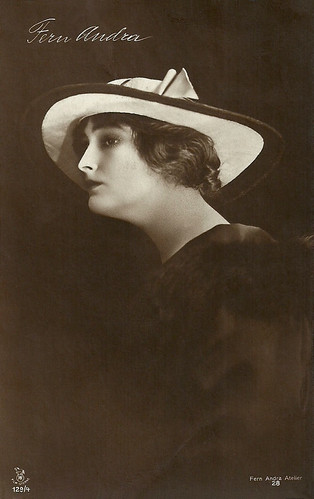
German postcard by Rotophot in the Film-Sterne series, no. 129/4. Photo: Fern Andra Atelier 28.

German postcard by Rotophot in the Film Sterne series, no. 142/1. Photo: Fern Andra Atelier.
German postcard by Rotophot in the Film-Sterne series, no. 151/1. Photo: Fern Andra Atelier.
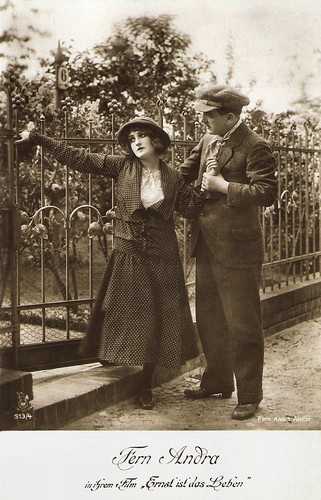
German postcard by Rotophot in the Film Sterne series, no. 513/4. Photo: Fern Andra Atelier. Still from Ernst ist das Leben/Life is Serious (Fern Andra, 1916). The actor is probably Fritz Delius. This card was sent to us by Gill4kleuren (Many thanks, Gill!).
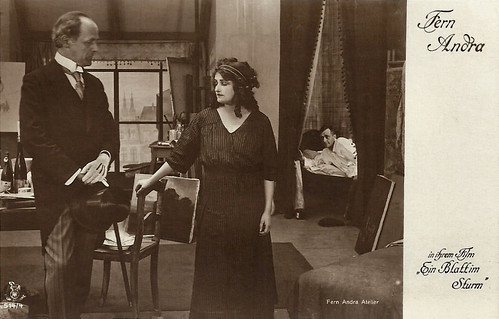
German postcard by Rotophot in the Film-Sterne series, no. 514/4. Photo: Fern Andra Atelier. Fern Andra and (in the back) Alfred Abel in the film Ein Blatt im Sturm... doch das Schicksal hat es verweht (Fern Andra, 1917).
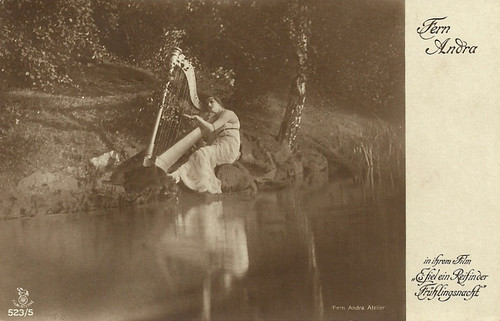
German postcard by Rotophot in the Film-Sterne series, no. 523/5. Photo: Fern Andra Atelier. Fern Andra in Es fiel ein Reif in der Frühlingsnacht (Fern Andra, Kurt Matull, 1915).

German postcard by Rotophot in the Film-Sterne series, no. 523/6. Photo: Fern Andra Atelier. Fern Andra in Es fiel ein Reif in der Frühlingsnacht (Fern Andra, Kurt Matull, 1915).
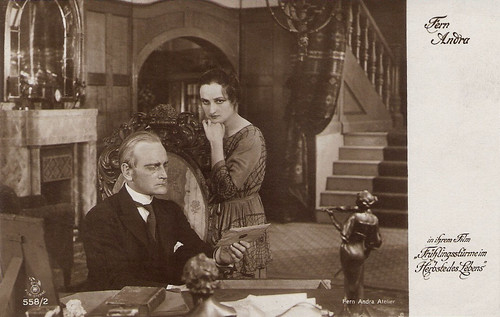
German postcard by Rotophot in the Film Sterne series, no. 558/2. Photo: Fern Andra Atelier. Still from Frühlingsstürme im Herbste des Lebens/Spring Storms (Fern Andra, 1918).
Victims of cruel events
After 4 or 5 of these films, André Fern left audiences breathless over so much defiance. She changed her name definitely to Fern Andra. On all our postcards (dating back to 1915), the name Fern Andra is used and no other variant. She started her own company, even directing her own films. Georg Glen was the manager of Fern Andra Atelier. The company produced more than 80 films during World War I.
When the USA entered World War I, Fern Andra became looked upon as an enemy and was suspected by Germany to be a spy because she was born in the USA. In order to make an end to these rumours, she got married to the Prussian Baron Friedrich von und zu Weichs-Zur-Wenne who was killed in the war a short time later.
Right during the First World War, Fern made one film after another, always about women who are victims of cruel events but who are also determined to settle matters. From 1916 to 1918 she often appeared on camera with Alfred Abel. She appeared mainly in sentimental dramas but also impressed critics with artistic performances in circus films. The new star created a sensation by mastering tight roping, riding horses without a saddle, driving cars, motorcycles, slalom, bobsleighing, and even boxing.
Moonlight romance, theatres burning down, and luxurious parties in aristocratic milieux. Unfortunately, most of these films were never exported because of the war, and most are lost now. Her films included Eine Motte floh zum Licht/A Moth Flew To The Light (Fern Andra, 1915), Frühlingsstürme im Herbste des Lebens/Spring Storms (Fern Andra, 1918) and Drohende Wolken am Firmament/Threatening Clouds in the Sky (Fern Andra, 1918).
In 1919 she published a novel entitled 'Der Weg, der ins Glashaus führte. Roman eines Frauenlebens', followed in 1920 by an autobiography entitled 'Was ich über mich zu sagen weiss'. Fern Andra was also aware of how to promote her movies and herself. She was so to speak a pioneer of "Making-Of" trailers in which she reported about accidents during the shooting and the work behind the scenes.
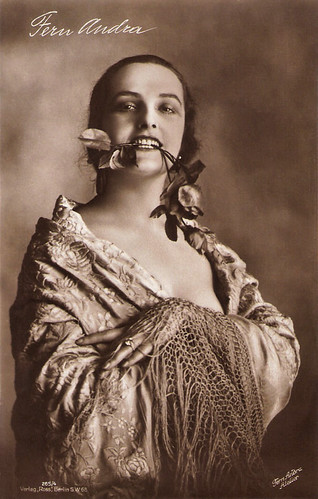
German postcard by Ross Verlag, no. 185/4. Photo: Fern Andra Atelier.
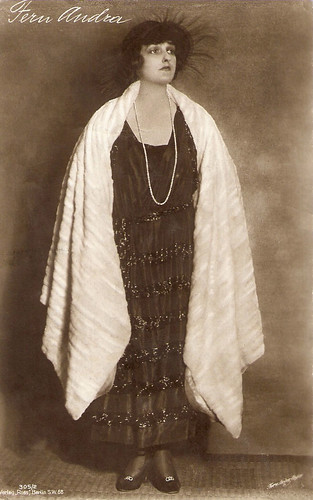
German postcard by Ross Verlag, Berlin. Photo: Fern-Andra-Atelier.
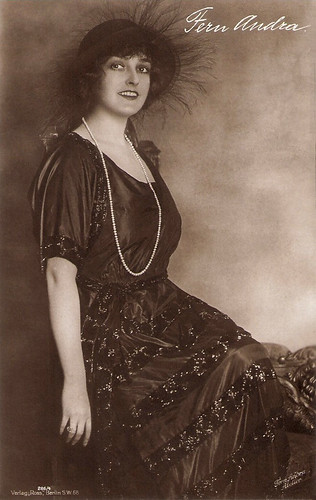
German postcard by Ross Verlag, Berlin, no. 286/4, 1919-1924. Photo: Fern Andra Atelier.

German postcard by Verlag Ross, Berlin / Rotophot, no. 288/1, 1919-1924. Photo: Fern Andra Atelier. Caption: Fern Andra at home. This is one of the few postcards which contains both references to Verlag Ross (front side) and to the Film Sterne series by Rotophot (flip side). Heinrich worked for Rotophot but in 1919, he founded the postcard company that bore his name, Ross Verlag (originally Verlag Ross). In the beginning, Verlag Ross operated as a distributor of postcards but soon became a publisher.
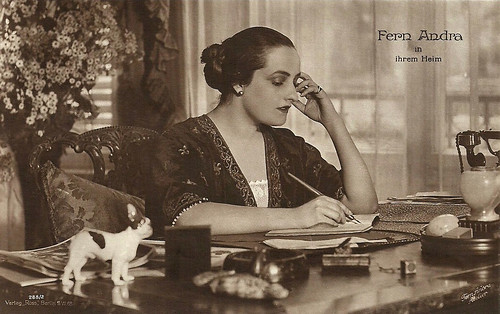
German postcard by Ross Verlag, Berlin, no. 288/2, 1919-1924. Fern Andra Atelier. Caption: Fern Andra in ihrem Heim (Fern Andra at her home).

German postcard by Ross Verlag, no. 385/5, 1919-1924. Photo: Atelier Schneider, Berlin.
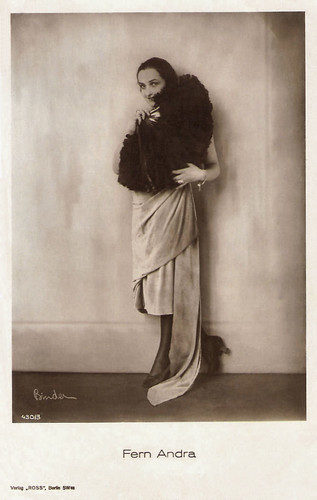
German postcard by Ross Verlag, no. 430/3, 1919-1924. Photo: Alex Binder.
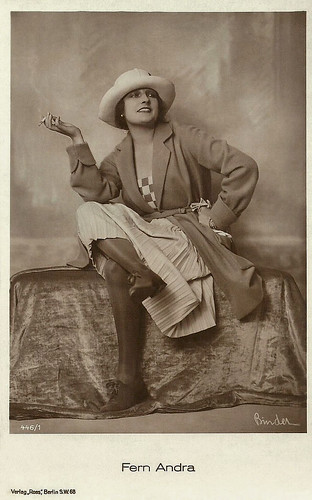
German postcard by Ross Verlag, Berlin, no. 446/1, 1919-1924. Photo: Alex Binder.

German postcard by Ross Verlag, Berlin, no. 447/1, 1919-1924. Photo Alex Binder.
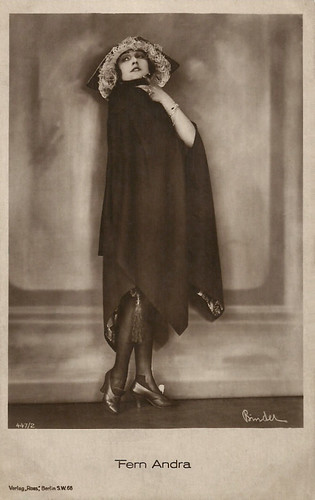
German postcard by Ross Verlag, Berlin, no. 447/2, 1919-1924. Photo: Alex Binder.
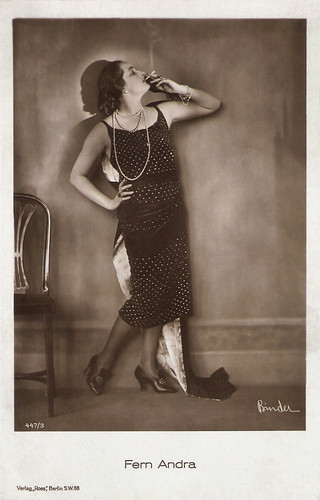
German postcard by Ross Verlag, Berlin, no. 447/3, 1919-1924. Photo: Alex Binder.
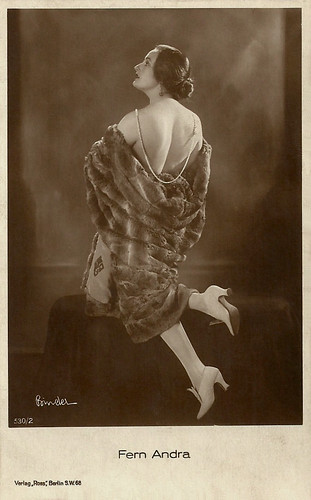
German postcard by Ross Verlag, Berlin, no. 530/2, 1919-1924. Photo: Alex Binder.
Mysterious Priest
In the early 1920s, Fern Andra's films became more sophisticated. She left direction to directors such as Robert Wiene. He directed her in Genuine (Robert Wiene, 1920), probably her best interpretation. Her Genuine is a vamp who uses her powers of seduction to torment and control the men who love her.
Wiene created Genuine as a follow-up to his massively successful film Das Cabinet des Dr. Caligari/The Cabinet of Dr. Caligari (1920), using the same writer, Carl Mayer, and cinematographer, Willy Hameister, who had worked on the earlier film. Production designer César Klein even returned to contribute his bizarre Caligari-like imagery to the film.
Andra's costumes in this film, specially designed for her by Klein, turned her mysterious priest of some cult into one of the most stylised characters of German expressionism. According to IMDb, he infuriated great arousal with an on-her-body painted costume by César Klein. However, the film did not do well at the box office.
On 4 July 1922, she was involved in the Hamburg-Berlin mail plane accident when the plane experienced engine failure and crashed. The pilot, Lothar von Richthofen, the younger brother of World War I flying ace Manfred von Richthofen (the Red Baron), was killed. Andra was initially misreported as dead but survived. Her companion, director Georg Bluen, also survived and continued working with her until 1925.
After a role as a femme fatale opposite the Italian apache Za-la-Mort (Emilio Ghione), in Der Traum der Za-la-Vie/The Dream of Za-la-Vie (Emilio Ghione, 1924), she said farewell to the German cinema with Frauen der Leidenschaft/Women of Passion (Rolf Randolf, 1926) in which she played Cléo de Mérode, and the comedy Funkzauber/Radio Magic (Richard Oswald, 1927) starring Werner Krauss and Xenia Desni.
In 1924, Fern Andra married the middleweight boxer Kurt Prenzel. The couple went to London where she made a few more films, including the drama Spangles (George Banfield, 1928). Then she moved to Hollywood, where she only made two films, the pre-Code dramas The Eyes of the World (Henry King, 1930) and Lotus Lady (Phil Rosen, 1930). Andra's activities on stage included acting at the Hollywood Playhouse in the 1930s. She also founded the Windsor Theater in Los Angeles. Her final stage appearance came in 1936.
Fern Andra was married four times. Her first husband was Baron Friedrich von und zu Weichs-Zur-Wenne. The marriage ended with his death in 1917. After her marriage to Kurt Prenzel had ended in a divorce, she was the wife of American film actor Ian Keith from 1934 to 1935. Her final husband was Gen. Samuel Edge Dockrell, from 1938 till his death in 1973. All of her unions were childless.
Fern Andra died in Aiken, South Carolina, in 1974, aged 80. She was interred at Cedar Hill Cemetery in Hartford, Connecticut.
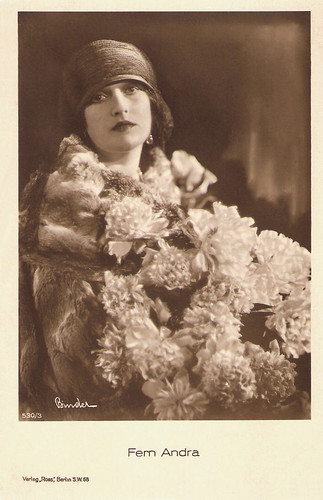
German postcard by Ross Verlag, no. 530/3, 1919-1924. Photo: Atelier Binder.
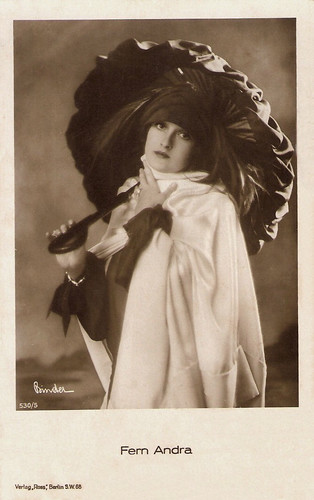
German postcard by Ross Verlag, Berlin, no. 530/5, 1919-1924. Photo: Alex Binder.
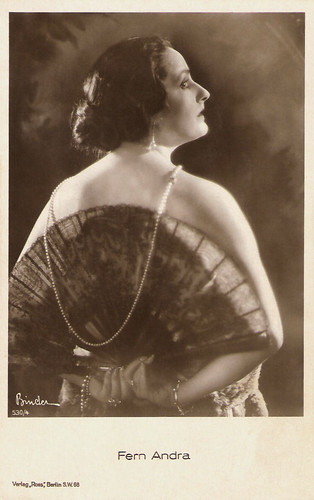
German postcard by Ross Verlag, Berlin, no. 530/4, 1919-1924. Photo: Alex Binder, Berlin.
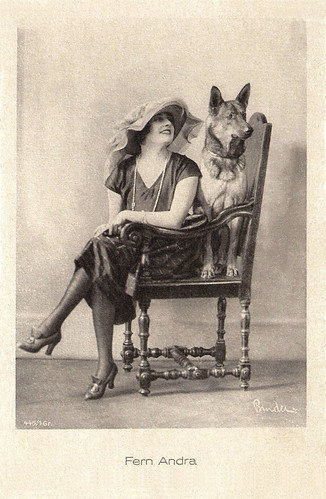
German postcard by Ross Verlag, Berlin, no. 445/1 Gr., 1919-1924. Photo: Alex Binder.

German postcard in the Film-Sterne series by Rotophot, no. 556/1. Photo: Fern-Andra-Atelier. Fern Andra in Des Lebens ungemischte Freude/Unmixed joy of life (Fern Andra, 1917).

German postcard in the Film-Sterne series by Rotophot, no. 557/3. Photo: Fern-Andra-Atelier. Fern Andra in Drohende Wolken am Firmament/Threatening clouds in the sky (Fern Andra, 1918), scripted by Fern Andra.

German postcard by Ross Verlag, no. 574. Photo: Fern-Andra-Atelier. Fern Andra and possibly Heinrich Braun in Auf des Lebens rauer Bahn/On the rough road of life (Georg Bluen, 1918).

German postcard by Ross Verlag, no. 580. Photo: Fern-Andra-Atelier. Fern Andra in Der Todessprung/Um Krone und Peitsche/Crown and Whip (Georg Bluen, Fern Andra, 1919).
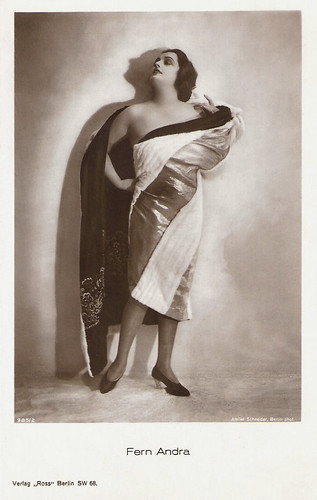
German postcard by Ross Verlag, Berlin, no. 982/2, 1925-1926. Photo: Atelier Schneider, Berlin.
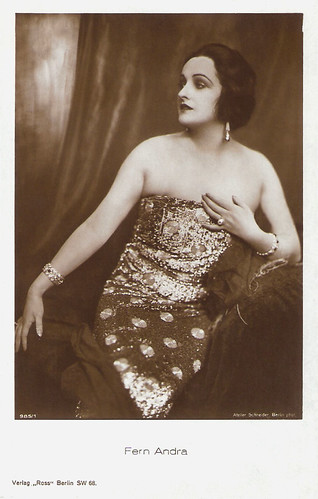
German postcard by Ross Verlag, Berlin, no. 985/1, 1925-1926. Photo: Atelier Schneider, Berlin.
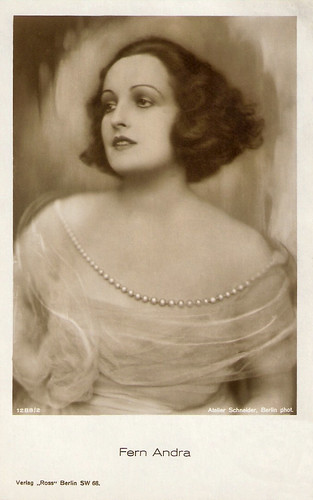
German postcard by Ross Verlag, Berlin, no. 1288/2, 1927-1928. Photo: Atelier Schneider, Berlin.
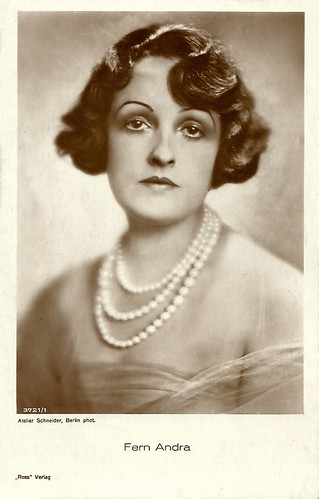
German postcard by Ross Verlag, no. 3721/1, 1928-1929. Photo: Atelier Schneider, Berlin.
Sources: Hans Michael Bock (Filmportal.de - German), Vittorio Martinelli (Le dive del silenzio) (Italian), Wikipedia (English and German) and IMDb. And our thanks to Tim Bergfelder for identifying Louis Brody on the Genuine postcard!
This post was last updated on 3 July 2022.
1 comment:
THANKS....
Post a Comment